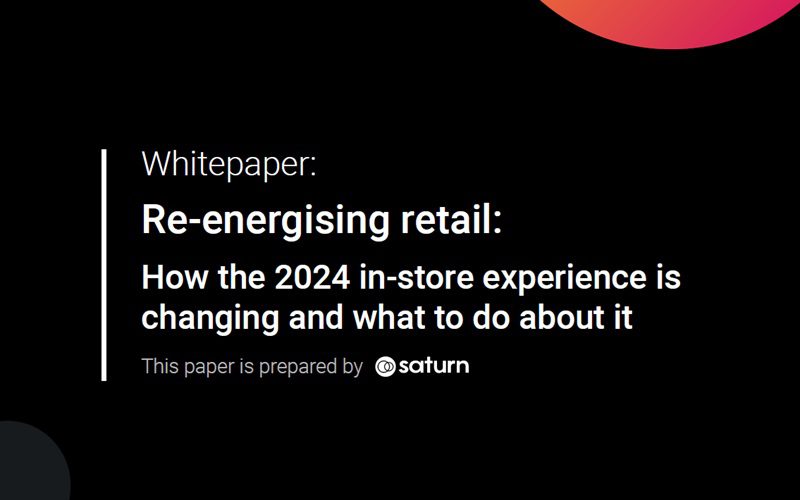Retail White Paper: Re-energising the in-store experience

About this white paper
This retail white paper, produced in 2024, is about in-store shopping. It comprises new research statistics on consumer preferences based on feedback from 2,000 UK full-time or part-time adult workers. It also contains a comprehensive overview of retail industry statistics from a range of other sources.
The result is an in-depth guide that highlights the approach to technology that retailers should adopt to stay appealing to modern consumers.
Download White Paper
Key takeaways
In this retail white paper you will learn:
- How the popularity of in-store shopping is changing in 2024
- How consumer preferences are changing with regards to bricks and mortar stores
- How supportive retail workers are of using digital technology in bricks and mortar stores
- Strategies that retailers can adopt to create ‘hybrid’ stores that have more appeal for the modern consumer
Re-energising the in-store experience – Overview
In the last six months, there has been a noticeable uplift in the popularity of physical retail stores. Brick-and-mortar spaces are once more proving a draw for shoppers who, after lockdowns and days monopolized by online activity, are keen to engage in real life again. However, their expectations have changed. They want retailers to deliver the best of both worlds – online and offline – in their stores.
New research commissioned by Saturn Visual Solutions, which is detailed within this retail white paper, has shown that modern stores that incorporating digital signage technology, such as interactive displays and screens, have a strong appeal for consumers.
The survey (conducted by OnePoll) of 2000 adults who live in the UK and are in full or part-time work, found the following:
- A quarter (25%) of respondents felt modern stores (with digital displays) make it easier to find out about new products
- Almost a quarter (22%) viewed modern stores with touchscreen digital displays as feeling more luxurious.
- Over a fifth (22%) viewed modern stores as being more fun.
- Another 13% said they often spent more than they had originally intended in modern stores.
- The research also identified that 89% of adults perceived certain types of retail stores as being more boring than others. The most boring stores selling FMCG goods were perceived to be cosmetics stores and pharmacies (16%).
- According to the same survey’s respondents, more than half said they would be likely to feel bored in a place that has nothing interesting to look at/watch. On average, they said they’d be likely to start feeling bored after just one minute if in a place that’s not actively stimulating them.
- More than half (56%) also said that they said that they would consider a ‘fun experience’ to be one that is visually interesting.
Digital signage offers an obvious way to achieve the kind of shopping experience people enjoy, but retailers are cautious about investing in new technology. It may still seem like an unnecessary and expensive risk or a mammoth undertaking – or both. Many are unclear about which solutions would deliver the best return on investment and are doubtful that their staff would support the changes.
Some retailers are already blazing a trail in this area and have seen a substantial increase in profitability after embracing technology and/or a hybrid approach. Expert analysis indicates that the tech-enabled store of the future has the potential to double retailers’ profitability by providing a better customer experience and greater employee engagement.
Understanding how to harness digital signage assets to achieve these outcomes means knowing what solutions are available and how each can address specific consumer needs. This paper will guide retailers to identify where to invest and catalyse their own in-store retail renaissance.
The current situation
A recent report from the Economist Intelligence Unit predicted that 2024 will see the strongest pace of growth for offline retail globally since the initial post-pandemic rebound of 2021. Additional research from Forrester revealed that offline retail growth in 2022 outpaced online retail growth for the first time across France, Germany, Italy, Spain, and the UK, with this momentum continuing into 2023. The research predicted that online retail sales growth in this European region would rebound to pre-pandemic levels in 2024 and beyond. However, offline sales are still on the rise and in the UK alone are forecasted to reach £368 billion in 2028, up from £336 billion in 2023.
We’re seeing increasing evidence of shoppers returning to stores, driven by a new hybrid blueprint for brick-and-mortar retail success. This centres on having the perfect blend of interactive tech and human contact in place – creating a positive multi-sensory experience which enhances online brand presence. The ideal scenario is to have a physical presence and a digital offering that enhance and complement each other. Especially when you consider that almost 70% of consumers now expect a personal and consistent customer experience across both physical and digital channels.
Retailers recognise this and, today, 62% of them believe the store is a ‘very important’ or ‘important’ part of their omnichannel strategy. But just under 30% feel that lack of focus on the in-store experience is a barrier to implementing a unified commerce strategy. There’s a clear imbalance here and retailers that stick with the status quo risk being left behind.
What consumers want
The online shopping experience has altered consumer expectations permanently. Now used to high levels of convenience, information-rich processes, and responsiveness online, people want to experience the same offline. Failing to meet these standards will create a gulf between brands and their customers. Digital signage can help retailers stay one step ahead, but any investment in this technology needs to be properly informed by today’s elevated consumer demands. Three key themes have emerged: experience, personalisation, and interactivity.
Experience – Having emerged from the pandemic lockdowns and with so much time spent online – around 4.2 hours daily in the UK – consumers are more likely to engage with retail spaces that promote social interaction and memorable moments. Over a third of consumers will shop with a brand again if they have had a good experience, even if there are cheaper or more convenient options available. Digital assets can help provide shoppers with the sense they are somewhere special.
Personalisation – Building consumer loyalty means forging lasting connections with shoppers. Personalisation is playing an increasingly important role in building those bonds. Online shoppers already experience recommended items, dedicated offers, and discounts. Now, they expect this to feature on an omnichannel level. Personalisation is evolving to new levels of emotional resonance, with 29% of consumers comfortable with brands tracking their emotions and personalizing experiences to their moods.
Interactivity – Consumers appreciate having access to tangible products they can touch and peruse. They seek out places where this is elevated by interactive digital tech. They respond positively to interactive screens and signage designed to make retail outings more convenient and reflective of their online brand experiences. Findings show that 35% of global consumers would go out of their way to visit a store with interactive virtual services.
What retail staff want
As the physical retail scene adapts, retail staff will be required to support consumers’ hybrid journey. Without staff engagement, digital media can only deliver part of its promise. When embraced by employees, it can add to a positive and efficient experience for customers and staff alike. A 2023 study by Retail Week found that 58% of store workers don’t feel secure in their roles, but over 80% think stores of the future will be more experience-focused. There is a clear appetite for technology to aid them in their roles, with 71% happy to embrace digital change and 86% saying tech is helping them do their job more effectively.
Delivering Success – Creating Digital Tech Enabled Retail Spaces
As consumer needs have evolved, so has technology. Digital signage now offers retailers the ability to forge a new type of experience that benefits them, their customers, and staff. As well as combining the benefits of both online and offline shopping, it can double up as an internal comms and support tool for staff. Too often, its potential is overlooked, but the savvy use of in-store media can help to deliver omnichannel consistency and enable personalised experiences to draw consumers back.
The PDF of of our retail white paper gives a snapshot of just some of the tech that’s available to retailers and how it can be used to deliver an improved customer experience and is free to download now.
If you have a retail project to discuss or want to learn more about using digital signage to enhance customer and staff experience, call our team now on 0161 222 0706 or email us at info@saturnvisual.com.
Ready to make an impact?
Get in touch now for competitive prices, good advice, & slick project delivery
